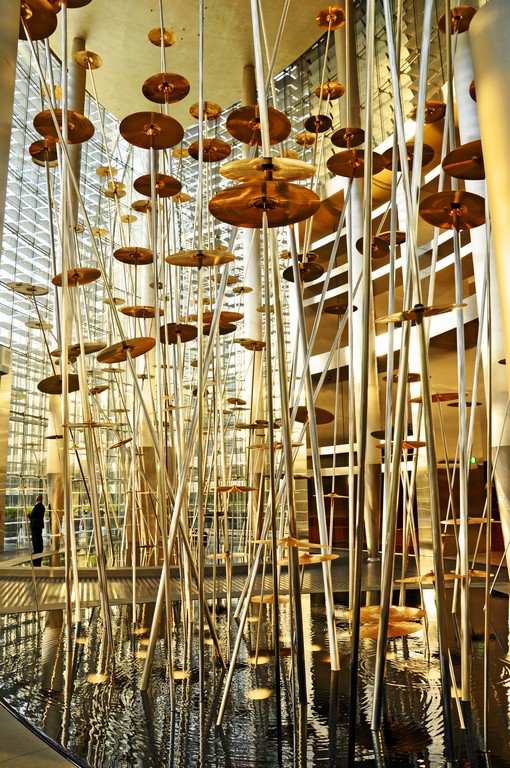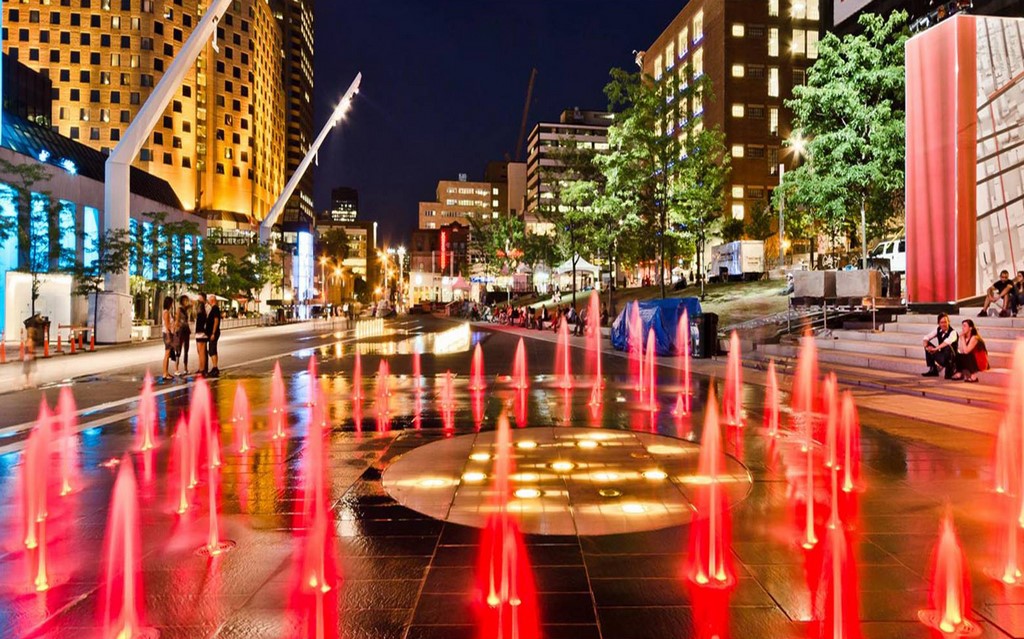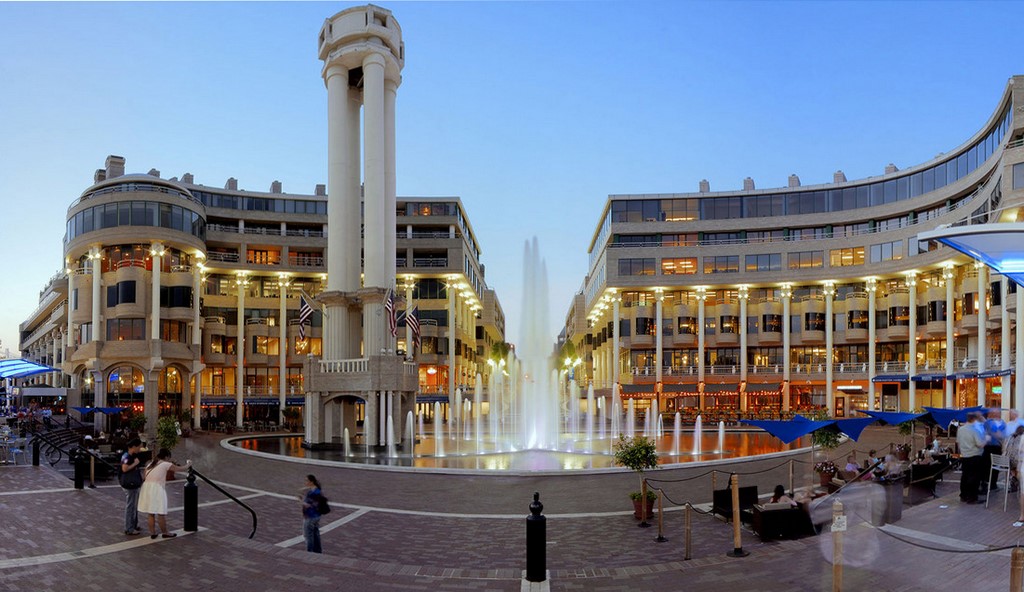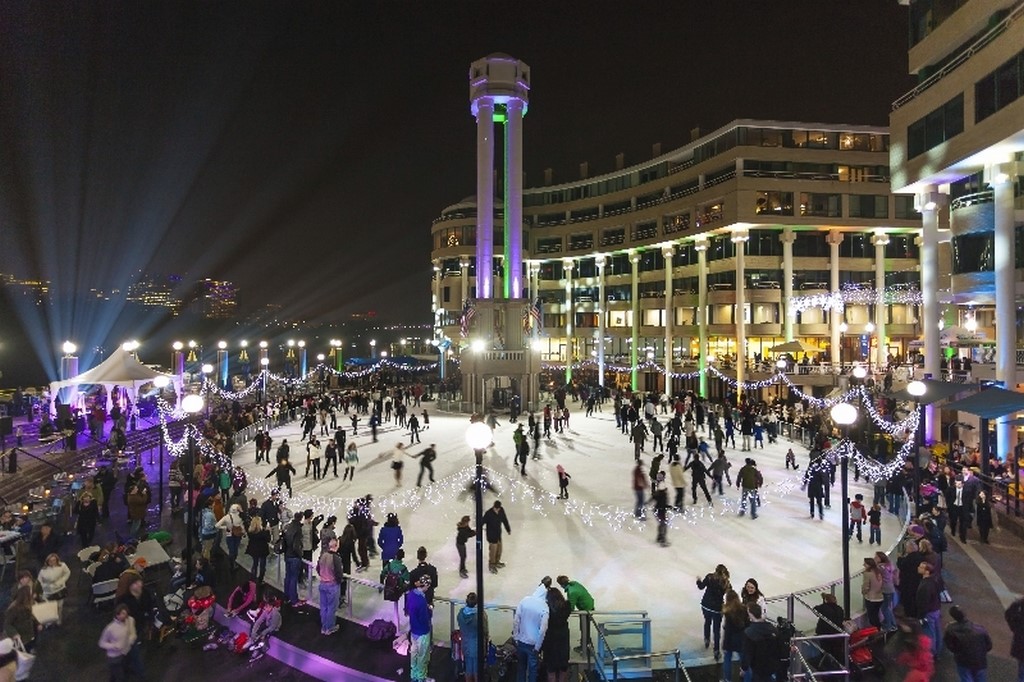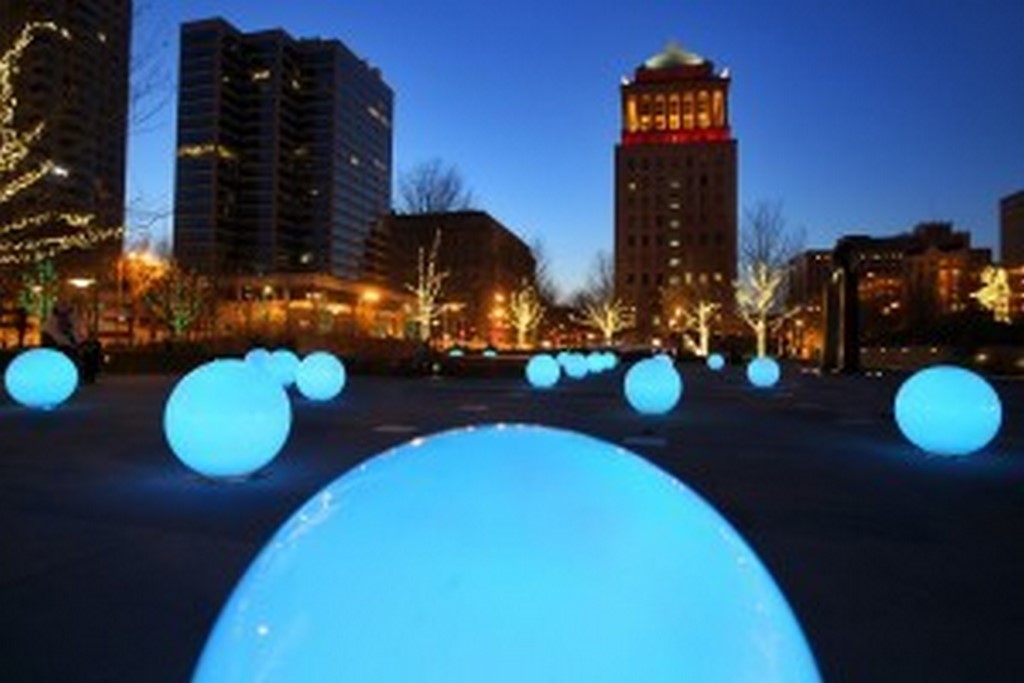Making Spaces
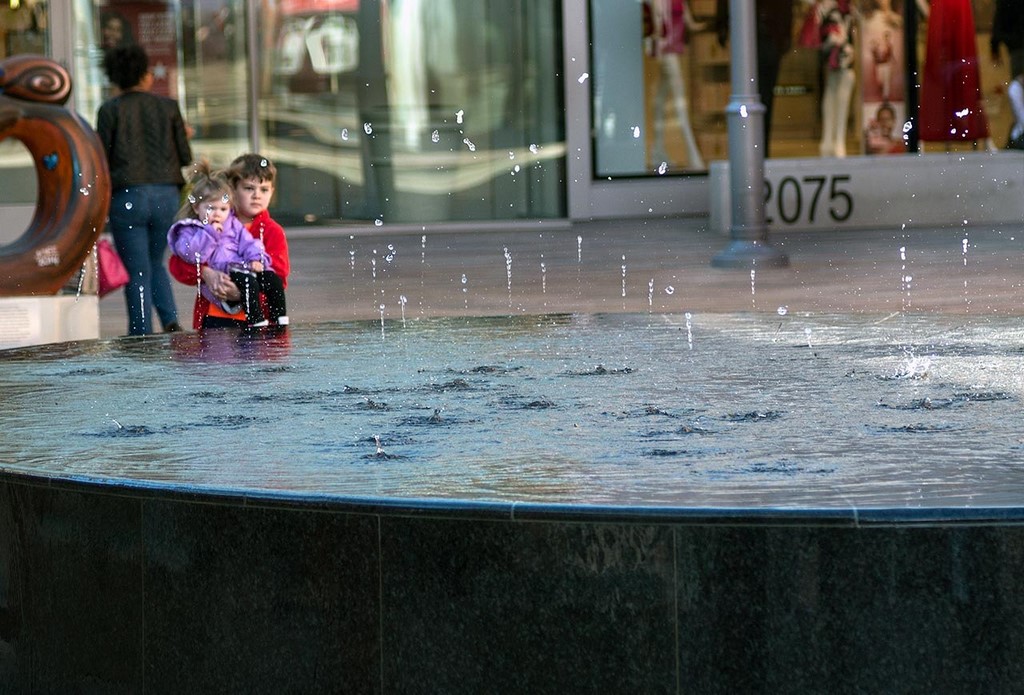
It’s easy to back up an assertion that a good fountain is the key to making a public space work.
A monumental statue is great, for instance, but when you add water even in the quiescent form of a reflecting pool, the visitor’s experience of the installation is enhanced in many ways. And while big, open plazas may serve as ready-made gathering places, if you add even a small fountain, the overall space will be defined by its presence and visitors will inevitably be drawn to it as a focal point.
Public fountains take many forms, but whatever the specifics, their inclusion says something important, something powerful about the setting, its ambitions and its ongoing ability to attract, entertain and delight the public. It’s common these days for architects and landscape architects to talk about “place-making,” and when it’s time to begin thinking along those lines, the optimal starting point is typically a memorable, compelling waterfeature.
So what kinds of thought processes go into making modern fountains as remarkable as the ones on display in this article? Let’s take a close look.
TRIPLED POTENTIAL
To get things going, let’s consider the three main classes of modern “water expression” – that is, the passive, the passive‐dynamic and the dynamic.
q Passive: These waterfeatures are synonymous with feelings of contemplation: They soothe onlookers, calm and cool their surroundings and draw people close to the water for serene, relaxing observation.
Some of the best of these installations feature a raised water table. Formerly, water was an enclosed, ground-level or ever-so-slightly-elevated experience – something along the lines of the reflecting pool fronting the Lincoln Memorial in Washington, D.C. But now these watershapes have been lifted to various heights in structures where the water is no longer contained (and concealed) behind a wall: The result is a fluid mass that comes “closer” to the viewer, thereby changing the perception of the water and making the installation all the more interesting and inviting (Figure 1A, below).

| Figures 1 A (left) and 1B (right), both illustrating raised water tables as well as the reflective value of dark interior finishes. |
The best thing about these raised features is that they can be very simple, particularly if the colors within the watershape are kept dark. Inky finishes create and enhance the illusion of depth and considerably augment the water surface’s reflective qualities and involvement with its surroundings (Figure 1B, above).
Of great importance in projects of a passive sort is the need to mask any and all visual elements that diminish or distract from the effect (that is, hiding the “uglies”), either within or beyond the water. Cables, junction boxes, suction and return fittings – anything that distracts from the serenity suggested by the waterfeature – all should be thoughtfully concealed from public scrutiny.
q Passive-Dynamic: In these applications, which can be considered a conceptual bridge between the purely passive and the truly dynamic, water can be used in unconventional or unexpected ways – almost how an artist works with paint on canvas.
This class of approach is a relatively recent development in fountain-making and in some instances is about placing voids within a smooth water surface and enabling the water to flow away into the gaps. To me, this is poetry, but some call it “negative water” in the same way swimming pool builders refer to negative or vanishing edges.
| Figures 2A (left), 2B (middle) and 2C (right), illustrating the progression from surface voids to a restored, ‘solid’ water surface – another possibility with installations featuring water tables. |
The difference here is that it’s not about a perimeter-overflow function: These water voids occur in the midst of a table-like surface and see water drop off in a way that brings a sense of fun and mystery and the unexpected to a setting. And that sense is enhanced when these systems are set up in such a way that the voids can vanish and allow the reappearance of a broad, uninterrupted sheet of water to establish a “solid” surface – a bit of watershaping sleight of hand (Figures 2A-C, above).
Alternatively, some passive-dynamic systems will use small jets to create raindrop-and-ripple effects. Here, small slugs of water break the still surface and put all sorts of oscillations and rippling patterns into play, turning a simple reflecting pool into an engrossing public entertainment (Figure 3A, below).
| Figures 3A (left), illustrating the use of small jets beneath the surface to agitate the water and create compelling patterns; and 3B (right), which demonstrates the utility of fog effects in bringing a sense of mystery and intrigue to a waterfeature. |
Fog and mist have a part to play in these systems, too – and sometimes an important one – through their inherent ability to add a touch of intrigue and mystery to any setting (Figure 3B, above). And in warm locales, there are few better ways to cool an open space!
q Dynamic: Some of today’s most joyful water expressions are of this sort and have been made possible by explosive growth and extension of jet, nozzle, lighting and control technology in recent years. These systems have taken what seems familiarly splendid and are pushing it toward spectacular.
This digitally controlled world includes fast vertical sequencing jets along with articulating jets or grand-scale air-driven systems of the sort seen in the world’s great musical and choreographed fountains, from the Bellagio in Las Vegas to Longwood Gardens in Kennett Square, Pa. (Figure 4A, below).
| Figures 4A (left), illustrating the amazing dynamism of modern fountain systems; 4B (middle), showing a surging, sequenced waterwall; and 4C (right), displaying the use of LED-illuminated mist to enhance tantalizing water effects. |
Surging waterwalls are another effective form of dynamic expression. This modern translation of the traditional waterwall includes more sophisticated designs made possible (and amazingly expressive) by highly sophisticated, incredibly flexible lighting and control systems. Waterway Square in The Woodlands, Texas is a great example of this and was set up as a sequence of individually controlled sections to allow for creation of a variety of surging patterns (Figure 4B, above).
As might be expected, fog and mist can take on more dramatic roles in dynamic systems than is true with the passive systems noted above. Unlike those traditional atomized fog systems, the new systems feature individually controlled mist nozzles that create a far more animated experience – one that can be dramatically enhanced in combination with LED lighting (Figure 4C, above). (See the sidebar below for details on lighting possibilities.)
DESIGN WATCHWORDS
The best part of all of this is that fountains developed with any of these basic approaches can serve their surroundings spectacularly – particularly if the designer knows a few techniques that can be used to turn a fountain into a focal point.
At the risk of oversimplifying what can be substantial conceptual challenges, there are three techniques fountain professionals are using these days to draw attention to their projects. I call one of them visual exclamation, which will take some explanation. The other two, entirely self-explanatory, are sound and reflectivity.
Visual exclamation is an umbrella term used to cover four possible design options, including verticality, water massing, repetition and lighting. Basically, what this means that an attention-grabbing fountain needs at its core some form of attention-grabbing design feature.
Some fountains include just one of these four elements – using, for example, a grand central plume that can be seen from a distance. Others encompass that central plume within the flows from a large numbers of jets, with the water massing around the plume (Figure 5A, below). Choreographed jets operating in distinct, discernible patterns are a similar draw – and any single or combined approach comes alive at night when deftly illuminated.
| Figures 5A (right), showing a combination of a central plume surrounded by massed flows in choreographed sequences; Figure 5B (middle left), capturing a sense of the white noise created by cascading water; Figure 5C (middle right), showing a calmer, softer flow through a comb weir; and 5D (right), illustrating a system in which droplets of water fall from a great height before hitting the resonant surfaces of cymbals. |
Compared to that basic element of appearance, the sound a fountain makes can be an underappreciated factor in a project’s success. Auditory cues can be transmitted well beyond the immediate space – or confined to a small setting. Again, it’s about the needs of the space and the sort of impression its fountain is asked to make.
|
Just Brilliant Among the most effective tools the fountain designer now has at his or her disposal is LED lighting technology, which is having dramatic effects on how we experience water in public places. Whether you work in a classic or tunable white light or play with colors (now available in 275 trillion unique hues), the possibilities are virtually endless – including pastels! – and the technology is now delivering all the intensity and brightness a designer could want. In fact, there’s now a need to be careful: It’s been reported that intensities are now extreme enough that, unmanaged, they can be hazardous to the human eye! — R.M. |
To bring sound into the equation, aerating flows and falling water can be used on the aggressive, white-noise end of the spectrum (Figure 5B, above), while low-level bubblers or comb-weir flows work on the softer side (Figure 5C, above). Collisions of water droplets with resonant surfaces also can be used to fill a space with sounds (Figure 5D, above). The important point to make here is that it always helps if these sounds – particularly on the aggressive side – can be tuned and adjusted as needed to set or suit the mood.
Finally, there’s reflectivity, another design factor that is often less than fully exploited. Whether a fountain pool is surrounded by shops on multiple levels or stands in a plaza reflecting mostly the sky, human beings have a fascination with seeing objects mirrored on these surfaces.
Flooded decks and perimeter-overflow basins do wonderful work in this respect. And recall from the discussion above that dark interior surfaces enhance reflectivity by adding to the sense of water depth as well as the sharpness/brightness of the reflections. Here, a simple gesture to water’s mirroring ability can turn an ordinary watershape into a constantly varied, constantly interesting attraction.
ARTISTIC TURNS
So, how do we use all of these techniques, tools and water expressions to highlight public spaces? This is where art enters the picture as expressed by designers who use water to conjure deep meaning or awe, create an educating moment or deliver polished entertainment.
One of the great assemblages of this artistry is Chicago’s Crown Fountain. As designed by Jaume Plensa, the iconic landmark has effectively redefined the meaning of “public space” for the 21st Century by turning a gathering spot into a fully functional urban statement. Its big, reflective flooded deck (45 feet wide and 230 feet long) is bookended by 50-foot-tall towers, and the images of people shown on the towers reflect the city’s great diversity (Figures 6A & 6B, below). It’s a multi-use/multi-function space that is undeniably both a work of art and a destination that defines the city.
| Figures 6A and 6B (left and middle left), showing Crown Fountain’s setting and the way it demonstrates the community’s diversity while calling on representatives of that diverse population to play in the water; and 6C and 6D (middle right and right), illustrating the convertibility of the Place des Festivals from fountain to performance space. |
Ever since the Crown Fountain appeared, there’s been a drive to design other multi‐use/multi-function urban spaces – and the commonality in all cases is that the results are both adaptable and inviting while they define the spaces they occupy. So now we see fountains doubling as concert or performance spaces, for example, as in the case of Montreal’s Place des Festival, a convertible space that moves from playful fountain to concert venue in no time at all (Figures 6C & 6D, above).
New technology has made it possible to create a user experience that we have never before seen. Through mobile technology, wireless control, innovative sensor arrays, game technology and augmented- and virtual-reality systems, interactivity is being driven to new levels. And fountain-making is doing what it takes to keep up by giving users – both professional fountain programmers and families at play in dancing waters – unprecedented control over immediate action and organized performance.
Consider the fountain systems installed on cruise ships as an example here: Part of the time they serve as the settings for aquatically themed entertainment – that is, when they aren’t being used for waterplay or as choreographed displays that fill the space with the sights and sounds of vigorous moving water (Figure 7A, below).
| Figures 7A (left), showing a cruise ship’s convertible fountain space – a setting for dancing and entertainment as well as active and passive waterplay; 7B (middle left), illustrating the Washington Harbor fountain and, in 7C (middle right), highlighting its wintertime use as an ice-skating rink; and 7D (right), indicating how a summertime splash deck in St. Louis becomes a wintertime art piece courtesy of the fountain’s LED lights. |
Consider as well the ways in which fountains are being used in urban renewal and renovation: In these contexts, fountains can remake spaces into productive and vibrant parts of any neighborhood – including, for example, Washington Harbor in the Georgetown neighborhood of Washington, D.C. (Figure 7B, above). In that particular case, existing infrastructure was a challenge and made for complications in hiding the “uglies.” But it all came together and both the owners and the public are thrilled by the way water has become the focal point of a hugely attractive public space.
The big change in outlook here – and the thought with which I’ll conclude this discussion – is that the driving philosophy behind so many of these modern fountains has to do with making them a useful, contributing part of the landscape 365 days a year, no matter where they’re located. This is just as true in cold-climate regions as it is on a ship plying the warm waters of the Caribbean, with flooded decks transformed into ice-skating rinks Figure 7C, above) or public-art spaces (Figure 7D, above) when the frost settles in.
It’s a new way of looking at familiar possibilities – and an exciting time to be a fountain-focused watershaper!
Robert Mikula is director of special projects at Crystal Fountains, an international waterfeature specialist based in Toronto, Ontario, Canada. He has more than 20 years’ experience in design and project management and is also a registered landscape architect who spent several years designing aquatic theme parks before taking his current post. Mikula is also active on the education front as a guest lecturer in the landscape architecture programs at both the University of Guelph and the University of Toronto and as a frequent participant in seminar programs at trade shows and symposia. He has also written numerous magazine articles on water effects, illumination and systems design. For more information, visit www.crystalfountains.com.






















